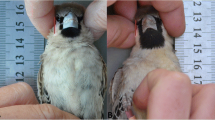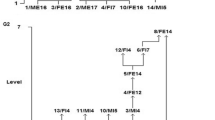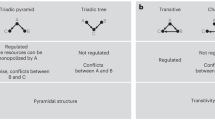Abstract
Dominance hierarchies are presumed to evolve by individual selection from an evolutionary compromise between intraspecific competition for resources and for mates. The hypothesis is put forward that when competition in “stable” habitats leads to “niche breadth,” a species is preadapted to life in heterogeneous environments and the consequent selection for fecundity. Status patterns are viewed as systems of signals communicating differential tendencies among individuals to attack or retreat, and a simple graphical model is presented which relates the costs or benefits to fitness of aggressive or appeasement behavior and interindividual distance. Primate societies are classified on the basis of their dominance hierarchies, and the ecological correlates of these patterns are discussed. Based on hypotheses presented in the paper, topics for future research are suggested.
Similar content being viewed by others
References
Brown, J. L., 1964. The evolution of diversity in avian territorial systems.Wilson Bull., 76: 160–169.
Carpenter, C. R., 1934. A field study of the behavior and social relations of howling monkeys.Comp. Psychol. Monog., 10: 1–168.
Chapman, M. &G. Hausfater, 1979. The reproductive consequences of infanticide in langurs: a mathematical model.Behav. Ecol. & Sociobiol., 5: 227–240.
Chivers, D., 1969. On the daily behavior and spacing of free-ranging howler monkey groups.Folia. Primatol., 10: 48–102.
————, 1977. The feeding behaviour of siamang (Symphalangus syndactylus). In:Primate Ecology,T. H. Clutton-Brock (ed.), Academic Press, New York, pp. 355–383.
Christen, A., 1974. Reproductive biology and behavior ofCebuella pygmaea andTamarin tamarin. Fortscrift Verhaltensforsch.Beihefte Z. Tierpsychol., 14: 1–80.
Clutton-Brock, T. H. (ed.), 1977.Primate Ecology. Academic Press, New York.
———— &P. H. Harvey, 1977. Primate ecology and social organization.J. Zool., London, 183:1–39.
Cody, M. L., 1974.Competition and the Structure of Bird Communities. Princeton Univ. Press, Princeton, New Jersey.
Davies, N. B., 1978. Ecological questions about territorial behaviour. In:Behavioural Ecology,J. R. Krebs &N. B. Davies (eds.), Sinauer Associates, Sunderland, Massachusetts, pp. 317–350.
Dawkins, R. &J. Krebs, 1978. Animal signals: information or manipulation. In:Behavioural Ecology,J. R. Krebs &N. B. Davies (eds.), Sinauer Associates, Sunderland, Massachusetts, pp. 282–312.
Downhower, J. &K. Armitage, 1971. The yellow-bellied marmot and the evolution of polygamy.Amer. Naturalist, 105: 355–370.
Eisenberg, J. H., N. A. Muckenhirn &R. Rudran, 1972. The relation between ecology and social structure in primates.Science, 176: 863–874.
Emlen, J. M., 1973.Ecology: An Evolutionary Approach. Addison-Wesley Pub. Co., Reading, Massachusetts.
Emlen, S. T. &L. Oring, 1977. Ecology, sexual selection and the evolution of mating systems.Science, 197: 215–223.
Froehlich, J. W. & R. W. Thorington, Jr., in press. The genetic structure and socio-ecology of howler monkeys (Alouatta palliata) on Barro Colorado Island. In:Ecology of Barro Colorado Island: Seasonal Rhythms and Long-term Changes in a Tropical Forest,E. G. Leigh, Jr. & A. S. Rand (eds.), Smithsonian Institution Press, Washington, D.C.
Gartlan, J. &C. Brain, 1968. Ecology and social variability inCercopithecus aethiops andCercopithecus mitis. In:Primates: Studies in Adaptation and Variability,P. Jay (ed.), Holt, Rhinehart & Winston, New York, pp. 253–292.
Geist, V., 1972. A comparison of social adaptations in relation to ecology in gallinaceous bird and ungulate societies.Ann. Rev. Ecol. Syst., 8: 193–207.
Glander, K., 1975. Habitat and resource utilization: an ecological view of social organization in mantled howling monkeys. Ph.D. Dissertation, Univ. of Chicago, Illinois.
Goodall, A., 1977. Feeding and ranging behaviour of a mountain gorilla group (Gorilla gorilla beringei) in the Tsibinda-Kahuzi Region (Zaire). In:Primate Ecology,T. Clutton-Brock (ed.), Academic Press, New York, pp. 450–480.
Goodall, J., 1965. Chimpanzees of the Gombe Stream Reserve. In:Primate Behavior,I. DeVore (ed.), Holt, Rhinehart & Winston, New York, pp. 425–473.
Hall, K. R. L., 1968. Behaviour and ecology of the wild patas monkey,Erythrocebus patas, in Uganda. In:Primates: Studies in Adaptation and Variability,P. Jay (ed.), Holt, Rhinehart & Winston, New York, pp. 32–119.
Hamilton, W. J., R. E. Buskirk &W. H. Buskirk, 1978. Omnivory and utilization of food resources by Chacma baboons,Papio ursinus.Amer. Naturalist, 112: 911–924.
Hausfater, G., C. D. Saunders & M. Chapman, in press. Computer models of primate life-histories. In:Natural Selection and Social Behavior,R. D. Alexander & D. Tinkle (eds.), Univ. of Michigan Press, Ann Arbor.
Hrdy, S. B., 1977. Infanticide as a primate reproductive strategy.Amer. Sci., 65: 40–49.
———— &D. B. Hrdy, 1976. Hierarchical relations among female Hanuman langurs (Primates: Colobinae,Presbytis entellus).Science, 1973: 913–915.
Jolly, A., 1966.Lemur Behavior. Chicago Univ. Press, Illinois.
————, 1972.The Evolution of Primate Behavior. Macmillan, New York.
Jones, C. B., 1978. Aspects of reproductive behavior in the mantled howler monkey (Alouatta palliata Gray). Ph.D. Dissertation, Cornell Univ., Ithaca, New York.
————. 1980. The functions of status in the mantled howler monkey,Alouatta palliata Gray: Intraspecific competition for group membership in a folivorous Neotropical primate.Primates, 21: 389–405.
Kawabe, M., 1966. One observed case of hunting behavior among wild chimpanzees living in the savanna woodland of Western Tanzania.Primates, 7: 393–396.
Kawai, M., 1958. On the system of social ranks in a natural troop of Japanese monkeys (I, II).Primates, 1: 111–148.
Kinzey, W. G., 1977. Diet and feeding behaviour ofCallicebus torquatus. In:Primate Ecology,T. H. Clutton-Brock (ed.), Academic Press, New York, pp. 127–152.
Kolata, G. B., 1976. Primate behavior: sex and the dominant male.Science, 191: 55–56.
Kummer, H., 1968.Social Organization of Hamadryas Baboons. A Field Study. Biblioteca Primatologica, Vol. 6, S. Karger, Basel.
Lindburg, D. G., 1977. Feeding behaviour and diet of rhesus monkeys (Macaca mulatta) in a Siwalik forest in North India. In:Primate Ecology,T. H. Clutton-Brock (ed.), Academic Press, New York, pp. 223–250.
Marler, P., 1965. Communication in monkeys and apes. In:Primate Behavior,I. DeVore (ed.), Holt, Rhinehart & Winston, New York, pp. 544–584.
McCracken, G. &J. Bradbury, 1977. Paternity and genetic heterogeneity in the polygamous bat,Phyllostomus hastatus.Science, 198: 303–306.
Otte, D., 1974. Effects and functions in the evolution of signaling systems.Ann. Rev. Ecol. Syst., 385–417.
Packer, C. &A. E. Pusey, 1979. Female aggression and male membership in troops of Japanese macaques and olive baboons.Folia Primatol., 31: 212–218.
Parker, G., 1974. Courtship persistence and female-guarding as male time-investment strategies.Behaviour, 48: 157–184.
Pollock, J. I., 1979. Female dominance inIndri indri.Folia Primatol., 31: 143–164.
Rasmussen, D. R., 1979. Correlates of patterns of range use of a troop of yellow baboons (Papio cynocephalus).Anim. Behav., 27: 1098–1112.
Richard, A., 1973. The social organization and ecology ofPropithecus verreauxi. Ph.D. Dissertation, Univ. of London.
Rowell, T. E., 1971. Organization of caged groups ofCercopithecus monkeys.Anim. Behav., 19: 625–645.
Sade, D. S., 1972. A longitudinal study of social behavior of rhesus monkeys. In:The Functional and Evolutionary Biology of Primates,R. Tuttle (ed.), Aldine, New York, pp. 378–398.
Schoener, T. W., 1971. Theory of feeding strategies.Ann. Rev. Ecol. Syst., 2: 369–404.
Schwartz, O. A. &K.B. Armitage, 1980. Genetic variation in social mammals: the marmot model.Science, 207: 665–667.
Sugiyama, Y., 1967. Social organization of Hanuman langurs. In:Social Communication Among Primates,S. A. Altmann (ed.), Univ. of Chicago Press, Illinois, pp. 221–236.
Suzuki, A., 1966. On the insect-eating habits among wild chimpanzees living in the savanna woodland of Western Tanzania.Primates, 7: 481–487.
Trivers, R., 1972. Parental investment and sexual selection. In:Sexual Selection and the Descent of Man,B. Campbell (ed.), Aldine, Chicago, pp. 136–179.
Tutin, E. G., 1980. Mating patterns and reproductive strategies in a community of wild chimpanzees (Pan troglodytes schweinfurthii).Behav. Ecol. Sociobiol., 6: 29–38.
West-Eberhard, M. J., 1975. The evolution of social behavior by kin selection.Quart. Rev. Biol, 50: 1–33.
Wiley, R. H. &P. Waser, 1980. Mechanisms and evolution of spacing in animals. In:Handbook of Behavioral Neurobiology, Vol. 3,P. Marler &J. G. Vandenbergh (eds.), Plenum, New York, pp. 159–223.
Wilson, E. O., 1975.Sociobiology: The New Synthesis. Harvard, Cambridge.
Wolfheim, J. G., 1975. Activity patterns and sex differences in behavior of talapoin monkeys (Miopithecus talapoin). Ph.D. Dissertation, Univ. of California, Berkeley.
Wrangham, R. W., 1977. Feeding behaviour of chimpanzees in Gombe National Park, Tanzania. In:Primate Ecology,T. Clutton-Brock, Academic Press, New York, pp. 504–538.
Zuckerman, S., 1932.The Social Life of Monkeys and Apes. Harcourt, Brace, New York.
Author information
Authors and Affiliations
About this article
Cite this article
Jones, C.B. The evolution and socioecology of dominance in primate groups: A theoretical formulation, classification and assessment. Primates 22, 70–83 (1981). https://doi.org/10.1007/BF02382558
Received:
Accepted:
Issue Date:
DOI: https://doi.org/10.1007/BF02382558




